|
|
Did you know that posture is often
the underlying cause -- and therefore
the only real long-term correction --
for most cases of on-going neck
pain and back pain?
A Definition of Terms
- Posture: body position and alignment
- Good posture practice: a) maintaining the normal shape of the spine, and b) satisfying the body's ongoing desire for motion
Posture may seem like an old-fashion concept to some people, but understanding and practicing good posture is more important today than it has ever been because we sit so often. We should be concerned about proper posture during all our activities, such as standing, bending, lying down, and lifting, but in particular we need help finding a comfortable and correct sitting posture.
As a modern society we spend more time sitting than we do in any other position. Yet, most people don't give much thought about how they sit, or how bad posture can damage their body. Over time, poor posture habits can lead to serious health problems such as deformity of the spine, degenerative arthritis of the joints, tightness and weakness of the muscles, general fatigue, chronic back and neck pain, and repetitive strain injury.
As people are generally living longer nowadays, there will be more time for the cumulative damaging effects of poor posture to catch up with you. Therefore, the awareness and practice of good posture is important now and in the future for people of all age groups.
The good news is that learning about posture is easy and intuitive, plus it's never too late to start! Listed below are the ten basic steps for understanding and practicing good sitting posture. For more complete information on good posture, the relationship between posture and back pain, a variety of posture tips, how to evaluate and improve your own posture, and how to stretch and exercise to avoid neck and back pain while sitting, check out The Science of Sitting Made Simple: How to look and feel better with good posture in ten easy steps book.
The Ten Basic Steps
|
 |
|
|
|
|
 |
|
|
Step One: A healthy spine is specifically shaped to maximize both strength and flexibility. When the body is in a neutral position, that normal spine shape is outwardly expressed as good posture. Notice the head is properly aligned over the shoulders, and the shoulders are properly aligned over the hips, in the back and the side views. Also notice from the side view that the neck and lower back areas of the spine are naturally arched forward.
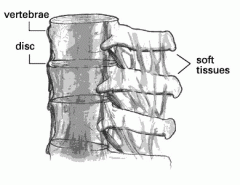
Step Three : Poor posture habits, over time, strain the connective soft tissues and bend the spine out of its normal shape, making it increasingly difficult to stand or sit up straight. In other words, you become molded into the position you are most often in—which for most of us has to do with the sitting position.
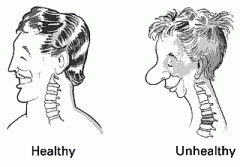
Step Five : When standing or sitting in a neutral position, a natural forward arch is normally present in the lower back area of your spine (called the lumbar lordosis). Standing on your own two feet, and with your back touching a wall or door, you should be able to slide your hand into that space between your pelvis and shoulder blades. It is important that you have an awareness of this naturally forward arched area of your lower spine.
Step Seven: Slumping is a bad habit that creates fatigue, increases the risk of repetitive strain injury, sports injury, spinal degeneration, and may result in permanent deformity. While ergonomic evaluations and equipment are important, people with poor posture awareness, habits and understanding manage to slump anyway. Increase your posture awareness with small visual reminders (such as our FREE monitor placard—see below)

Step Nine : Good sitting posture is essential to minimize stress and strain, however, it is still sedentary. When you sit for long periods of time, your body's systems become idle, which promotes many health-related problems. Periodic motion of moderate intensity can help recharge your breathing and blood flow to keep you healthier and more alert. (Use our FREE Weekly Self-Care Record to track your progress—see below)
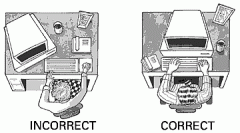
|
|
 |
 |
|
|
Step Two: The spinal bones (vertebrae) are held in place by connective soft tissue structures, such as muscles, tendons, ligaments, and discs, that play a major role in determining the shape and mobility of the spine. Changes in the shape of the spine during movement (twisting and bending), and from poor posture (slumping), are mostly due to changes in the connective soft tissues holding the spinal bones together—not changes of the vertebrae themselves.
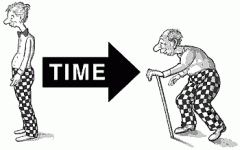
Step Four : When the spine is bent out of its normal shape, the vertebrae and soft tissues wear unevenly, and become hardened by the process of degeneration (decay). At areas of greater strain, the vertebrae grow irregular bone spurs, the connective soft tissues become fibrotic and form scars / adhesions, the joint spaces narrow, the joint surfaces roughen, and the discs between the vertebrae dry up and thin out.

Step Six : Good (working) sitting posture involves keeping your body erect by scooting your buttocks all the way against your seatback, locking your setback in an upright (nearly vertical) position, and supporting the natural forward arch in your lower back. You must maintain the normal contours of your spine, distribute your lower body weight evenly on the seat bottom, and direct your upper body weight fully into the seatback to sit correctly and relaxed.

Step Eight : Improper sitting, or long periods of deskwork, often causes the head to poke forward and the body to become rounded forward, deforming the normal shape of the spine. Extension stretching with a small, tightly rolled towel supporting your neck can help you relax tight postural muscles, regain a healthier spinal position, and return to a neutral posture. (consult with your doctor before trying this stretch).
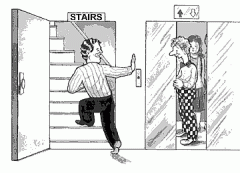
Step Ten : Good posture practice is an awareness of the normal shape of your spine, maintaining a neutral spine position and supporting your natural spinal contours during rest and activity, and satisfying your body's on-going desire for motion by avoiding prolonged sedentary periods and getting regular bouts of movement throughout your day.
|
|
|
|
|
|
